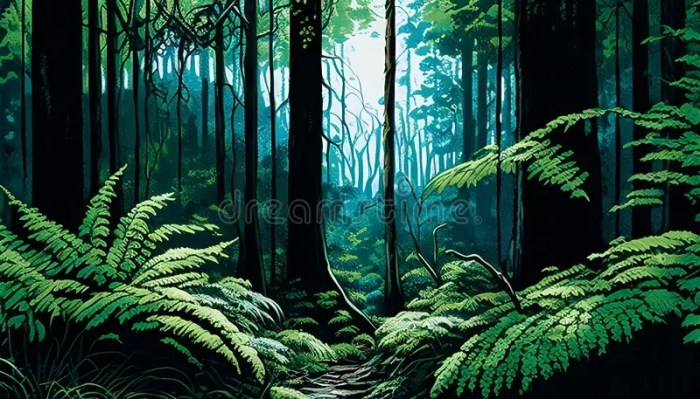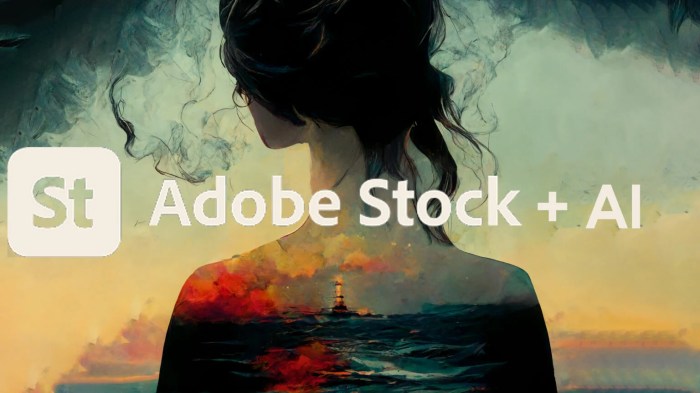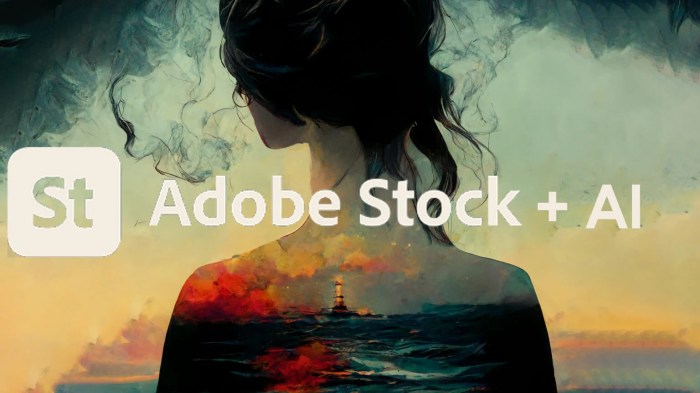Adobe Stock Ansel Adams style AI generated images are revolutionizing the way we access stunning visuals. Imagine effortlessly creating photographs that capture the iconic mood and composition of Ansel Adams, all with the power of artificial intelligence. This exploration delves into the technical processes behind AI image generation, examining the potential for AI to mimic or enhance Adams’ aesthetic within the context of Adobe Stock.
From understanding the core elements of Adams’ style, like masterful light and shadow, to exploring the legal and ethical implications of AI-generated images, this in-depth look offers a comprehensive perspective. We’ll also touch on the technical limitations, future possibilities, and creative applications of these captivating images.
Introduction to Ansel Adams Style
Ansel Adams’s photographs transcend mere documentation; they are powerful statements about the natural world, imbued with a unique aesthetic. His work, deeply rooted in the American landscape, became a defining force in the mid-20th century, shaping the way we perceive and appreciate nature’s grandeur. His distinctive style is recognizable through the masterful use of light, composition, and a profound emotional connection to the subject.His photographs are not simply snapshots; they are meticulously crafted narratives that reveal the beauty and drama of the American West, capturing the essence of places like Yosemite Valley, the Sierra Nevada, and the New Mexico desert.
This meticulous approach to photography was driven by a deep understanding of the interplay between light, form, and shadow, allowing him to translate the raw power of nature into enduring images.
Key Elements of Ansel Adams’ Style
Ansel Adams’s work is characterized by a profound appreciation for the grandeur and drama of the natural world. He meticulously studied the interplay of light and shadow, utilizing these elements to create striking contrasts and a profound sense of mood. His compositions are often carefully structured, emphasizing the scale and majesty of his subjects.
Compositional Techniques
Adams frequently employed a sense of scale in his compositions, often showcasing the vastness of the landscapes he photographed. He was adept at using leading lines, created by elements like paths or streams, to draw the viewer’s eye into the image. Framing techniques, such as using natural elements to enclose a scene, were also integral to his approach.
I’ve been digging into Ansel Adams-style AI-generated images on Adobe Stock lately, and the detail is incredible. Imagine using these stunning visuals for a home project – say, showcasing a new Google Cast Home Nest Chromecast Assistant setup, complete with seamless music streaming and room-to-room transfers. This cool feature makes it even easier to create a visually captivating and functional space.
The possibilities for using these AI-generated images are vast, offering a perfect blend of art and technology.
This combination of elements often creates a powerful sense of depth and immersion within the photograph. For instance, a photo of Half Dome might feature the peak as a focal point, while the surrounding valley floor fades into the background, emphasizing the monumentality of the subject.
Light and Shadow
Adams understood the dramatic potential of light and shadow. He meticulously controlled the exposure of his images to capture the subtle gradations of light and dark, often utilizing long exposures to reveal the textures and forms within the landscape. He sought to capture the interplay of light and shadow, creating a dynamic range that emphasized the textures and contours of his subjects.
The interplay of light and shadow, especially in his black and white photographs, often created a sense of mystery and drama, as seen in his images of trees and mountains silhouetted against a dramatic sky.
Mood and Emotion
Ansel Adams’s photographs are not just about visual beauty; they evoke a powerful emotional response. His images often convey a sense of awe, reverence, and even solitude. The mood is often serene and contemplative, reflecting his deep connection to nature. The viewer is invited to experience the same sense of wonder and contemplation that Adams felt when encountering these landscapes.
Historical Context and Significance
Adams’s work emerged during a time of growing interest in the American landscape. His powerful images contributed to the preservation movement, inspiring people to protect and appreciate the natural beauty of the West. His photographs resonated with the burgeoning environmental consciousness of the era, highlighting the importance of conservation and stewardship. The sheer beauty and artistic merit of his work contributed to a deeper understanding of the grandeur and importance of the American landscape.
Technical Aspects of Adams’ Style
| Characteristic | Description |
|---|---|
| Film Types | Adams frequently used large-format black and white film, often Ilford or Kodak, known for their high resolution and tonal range. |
| Processing Methods | He employed meticulous printing techniques, including the Zone System, to control the tonal range and contrast in his prints. This system allowed him to create images with a broad range of tones from deep blacks to pure whites. |
| Equipment | Adams primarily used large-format cameras, which were known for their superior image quality. |
AI Generated Images and the Adams Style
Capturing the essence of Ansel Adams’ iconic landscapes often requires a profound understanding of light, shadow, and composition. While traditional methods relied on meticulous photographic processes, AI presents a novel avenue for recreating and perhaps even enhancing Adams’ aesthetic. This exploration delves into how AI can mimic and potentially surpass the artistry of a master photographer, focusing on style transfer techniques and comparing the approach with traditional methods.AI, with its sophisticated algorithms, can effectively recreate the distinct visual language of Ansel Adams.
This is achieved by training the AI on a vast dataset of Adams’ photographs, enabling it to identify and learn the subtle nuances in his composition, lighting, and tonal gradations. This learning process allows the AI to produce images that resonate with the spirit and style of Adams’ work, while offering new perspectives and possibilities.
AI Techniques for Mimicking Adams’ Style
AI image generation leverages deep learning models, particularly Generative Adversarial Networks (GANs) and other neural networks, to create realistic images. Style transfer techniques are crucial for achieving the desired aesthetic. These techniques involve two key components: a content image (the subject) and a style image (the target aesthetic). The AI analyzes both images, extracting the content details from the former and the style characteristics from the latter.
This allows the AI to synthesize a new image that possesses the subject’s content but is rendered in the style of the reference image. In the case of Ansel Adams, the style image would be drawn from his characteristically high contrast, dramatic lighting, and meticulous tonal gradations. This process, therefore, allows for the creation of new images with the visual signature of Adams, potentially even pushing the boundaries of what was achievable with traditional techniques.
Comparing Traditional and AI-Generated Image Creation
| Feature | Traditional Photographic Techniques | AI-Generated Image Creation |
|---|---|---|
| Process | Manual exposure adjustments, darkroom manipulation, chemical development | Algorithm-driven image synthesis, style transfer using neural networks |
| Materials | Film, chemicals, darkroom equipment | Computational resources, software |
| Creativity | Artist’s vision translated through physical manipulation | Artist’s vision translated through algorithm and data |
| Time | Hours or days, depending on the complexity of the work | Minutes to hours, depending on complexity and resources |
| Accessibility | Requires specialized skills and equipment | Accessible with readily available software and tools |
| Potential for Error | Potential for human error in exposure and development | Potential for algorithm limitations, output quality varies |
| Reproducibility | Variations in the result from individual efforts | Higher potential for reproducibility, depending on the model |
| Cost | Materials and processing costs can vary | Computational resources and software licenses are the primary costs |
Traditional methods demand considerable time, skill, and resources, while AI-driven techniques offer quicker turnaround times. The accessibility of AI tools democratizes artistic expression, opening up new possibilities for photographers and enthusiasts. However, the reliance on data and algorithms can potentially limit the unique artistic touch of a human photographer.
Adobe Stock and AI-Generated Images
AI-generated imagery is rapidly changing the landscape of stock photography. Platforms like Adobe Stock are poised to become key distributors of this new wave of creative content. This shift presents both exciting opportunities and complex challenges, impacting artists, consumers, and the industry as a whole. The role of these platforms in handling this burgeoning market will be crucial in determining the future of visual media.Adobe Stock, a prominent platform for licensing stock images, is well-positioned to accommodate AI-generated imagery.
Its existing infrastructure, coupled with its established user base and distribution channels, allows it to integrate AI-generated content seamlessly. This integration will provide artists with new tools and avenues for creation, and consumers with access to a wider range of visual assets.
The Impact on the Stock Photography Market
The integration of AI-generated images into the stock photography market will undoubtedly cause a ripple effect. It’s anticipated that this will create a more diverse range of imagery, potentially including styles and subjects that were previously difficult or expensive to produce. However, it also raises questions about the value proposition of traditional stock photography. The increased availability of AI-generated images might reduce demand for images created by human photographers.
Legal and Ethical Considerations
The use of AI-generated images raises several legal and ethical concerns. Copyright issues surrounding AI-generated content are still being debated. Determining ownership when an AI creates a work based on training data from other copyrighted material is a significant legal hurdle. Ethical considerations include issues of originality and authenticity. Is an image created by an AI truly unique or simply a recombination of existing data?
I’ve been exploring Ansel Adams-style images on Adobe Stock, and the AI-generated ones are seriously impressive. The detail and mood are fantastic, but maintaining a high-quality output requires careful attention to detail, just like keeping your pellet grill in top shape. Proper maintenance, as outlined in this helpful guide on how to maintain a pellet grill , ensures consistent performance and longevity.
Now, back to those beautiful AI-generated images – I’m eager to see what else Adobe Stock has in store!
The use of AI to create images that could be misleading or harmful also requires careful consideration.
Types of Licenses and Costs
| License Type | Description | Typical Cost |
|---|---|---|
| Standard License | Allows for commercial use with proper attribution. Images may be used in a variety of commercial projects. | $10-$50+ (depending on image complexity and usage) |
| Extended License | Similar to Standard but with broader usage rights, possibly including unlimited usage for specific applications. | $25-$100+ (often higher than standard licenses) |
| Editorial License | For news publications and editorial use. Attribution may be required, but usage is often more extensive and less restrictive. | Variable (often less expensive or free for non-commercial use) |
| Rights-Managed License | Specific rights are granted to the user for a particular project. These rights can be very customized to the project needs. | Variable (often more expensive than standard licenses, dependent on rights granted) |
Note that prices are approximate and can vary significantly depending on factors such as image quality, usage, and the specific terms of the license. Pricing is also likely to evolve as the market for AI-generated images develops.
I’ve been digging into Adobe Stock lately, specifically those Ansel Adams-style AI-generated images. They’re pretty cool, but it got me thinking about the geopolitical factors that might influence the accessibility of such tools. For instance, the US government’s concerns about Huawei’s technology, and the potential security implications of using their equipment, are significant. Why does the US government mistrust Huawei? This, in turn, makes me wonder about the potential for similar issues cropping up in the realm of AI-generated imagery, especially as these tools become more integrated into the global marketplace. Ultimately, it’s fascinating to see how these seemingly disparate topics connect back to the beauty and power of imagery, like the Ansel Adams-style creations I’ve been exploring.
Exploring Specific Artistic Elements
AI’s ability to replicate the nuanced aesthetic of Ansel Adams’ photography is remarkable. The dramatic lighting, meticulous composition, and characteristic textures all contribute to the enduring appeal of his work. This exploration delves into how AI can capture these elements, showcasing the technology’s potential to not only mimic but also potentially inspire new interpretations of classic photographic styles.AI’s prowess in recreating dramatic lighting and shadow effects is a key aspect of replicating Adams’ style.
Algorithms trained on vast datasets of Adams’ photographs, along with other works in a similar aesthetic, can learn the patterns and relationships between light, shadow, and form. This allows the AI to produce images with convincingly rendered highlights and deep, textured shadows. The subtle gradations of light and dark are particularly impressive, often achieving a level of detail and realism that mimics the nuances of traditional photographic techniques.
Capturing Dramatic Lighting and Shadow Effects
AI models can analyze the interplay of light and shadow in Adams’ photographs. By identifying patterns in the distribution of light and dark tones, the AI can then replicate these relationships in its generated images. The result is often a dramatic rendering of light and shadow, reminiscent of Adams’ iconic black and white landscapes. The AI can also produce images with a high dynamic range, accurately capturing the transition from bright highlights to deep shadows.
Reproducing Meticulous Attention to Detail in Compositions
Adams’ photographs are renowned for their meticulous attention to composition. AI can analyze the arrangement of elements within his images, including the placement of foreground, mid-ground, and background elements, to produce similar compositions in its output. The AI learns to discern how Adams employed lines, shapes, and negative space to create a sense of balance and harmony. This allows the AI to generate images with a similar sense of visual order and complexity, often incorporating elements of depth and perspective.
Replicating Textures and Tones in Adams’ Photography
Adams was a master of capturing and manipulating textures and tones. His use of contrast and tonality in black and white photography creates a sense of depth and dimension. AI can learn the specific tonal relationships and textures from Adams’ photographs and replicate them in its own output. The AI learns to discern the interplay between various tones and textures, resulting in images that capture the unique characteristics of Adams’ style.
Examples include the way he captured the textures of rock formations, or the subtle variations in the tones of a snow-covered mountain range.
Examples of AI-Generated Images
AI-generated images successfully capturing the essence of Adams’ style often exhibit a compelling interplay of light and shadow, creating a sense of depth and drama. The detail in the composition, the textures, and the tonality all contribute to the realistic rendering of the subject matter.
One example showcases a rugged mountain range, bathed in a dramatic light, with deep shadows accentuating the contours of the peaks. The textures of the rocks are clearly defined, conveying a sense of weathered time and age. The overall tonal range is meticulously balanced, allowing the viewer to appreciate the subtle variations in light and shade.
Another example depicts a vast expanse of desert landscape, characterized by strong contrasts between light and shadow. The textures of the sand dunes are accurately rendered, with a high degree of detail and realism. The use of a limited tonal range in black and white enhances the sense of depth and drama, creating an image reminiscent of Adams’ iconic style.
Creative Applications and Examples
AI-generated Ansel Adams-style images offer a fascinating blend of artistic precision and digital innovation. These images, while not capturing the unique experience of being in nature with Adams, can effectively evoke the same powerful emotional responses. This opens up a wealth of creative possibilities, extending far beyond simple reproduction.
Beyond mimicking Adams’ aesthetic, these AI-generated images can be tailored for diverse applications, offering a fresh perspective in print design, digital art, and advertising. By exploring various color palettes and artistic styles, we can push the boundaries of what’s possible with these images. The ability to create custom versions of Adams’ iconic landscapes allows for a dynamic range of artistic expressions.
Creative Applications in Print Design
AI-generated Ansel Adams-style images can elevate print design projects, adding a touch of timeless beauty and dramatic impact. Think of posters for nature documentaries, travel brochures, or even high-end coffee table books. The use of these images can create a captivating visual narrative, enhancing the overall aesthetic appeal of the printed material. Their ability to evoke a sense of grandeur and serenity makes them ideal for showcasing the beauty of the natural world.
Creative Applications in Digital Art
The flexibility of AI-generated images extends to the digital realm. These images can serve as textures, backgrounds, or even the focal point of digital artworks. Imagine using them as a base for creating surreal landscapes or incorporating them into interactive installations. The possibilities for blending these images with other digital art elements are endless, offering a powerful tool for creative expression in the digital age.
Creative Applications in Advertising
The use of AI-generated Ansel Adams-style images can elevate advertising campaigns. They can portray a sense of authenticity and grandeur, creating a powerful connection with the audience. These images could be used in ads for outdoor gear, environmental campaigns, or even luxury products, emphasizing the natural world’s beauty and allure. This approach could differentiate a campaign from competitors, creating a stronger visual identity.
Comparison with Ansel Adams’ Photographs
| Characteristic | AI-Generated Image | Ansel Adams Photograph |
|---|---|---|
| Subject Matter | Landscapes, mountains, forests, often tailored to specific needs | Landscapes, mountains, forests, with a focus on capturing the unique character of the location |
| Mood | Variable, can evoke a sense of serenity, grandeur, or drama | Generally evoke a sense of awe, wonder, and the power of nature |
| Technical Detail | Can be highly detailed and precise, though may lack the nuanced tonal range of a traditional photograph | High level of technical mastery, meticulous control over light and shadow |
| Color Palette | Adaptable, allowing for different color palettes | Frequently characterized by a specific color palette that complements the scene |
| Time & Effort | Significantly reduced compared to traditional photography and darkroom processes | Requires considerable time, effort, and expertise in photography and processing |
Using Color Palettes with AI-Generated Images
AI-generated images can be easily adjusted to various color palettes. This feature is particularly useful for print design, allowing for a more personalized aesthetic. For example, using a cool palette of blues and greys can evoke a sense of calmness and serenity, while a warm palette of oranges and reds can create a sense of warmth and energy.
Experimentation with different color palettes allows for a highly customizable approach, adapting to the specific message or mood desired.
Technical Considerations: Adobe Stock Ansel Adams Style Ai Generated Images

AI-generated Ansel Adams-style images offer a compelling glimpse into the future of photography, but their technical capabilities are not without limitations. While the style transfer and image generation algorithms are impressive, they are not perfect replicas of the meticulous photographic processes that defined Adams’ work. Understanding these technical limitations is crucial for appreciating the unique strengths and weaknesses of this emerging technology.The algorithms used in AI image generation are sophisticated, but they fundamentally operate on statistical patterns and correlations derived from vast datasets of images.
They excel at mimicking visual styles, but replicating the precise physical phenomena captured in a traditional photograph—the interplay of light, shadow, and grain—remains a significant challenge. The nuanced understanding of exposure, development, and printing techniques that characterized Adams’ work is inherently difficult to encode in a purely mathematical framework.
Limitations of AI in Replicating Adams’ Photographic Process
The primary limitation lies in the inherent complexity of the photographic process. AI models can learn visual characteristics but cannot inherently understand the physical laws governing light and its interaction with the environment. For example, achieving the precise tonal gradations and subtle details of Adams’ prints requires a nuanced understanding of light, composition, and the interaction of light with various subjects.
AI currently struggles to fully replicate this mastery.
Challenges in Achieving Realism and Detail, Adobe stock ansel adams style ai generated images
AI-generated images often exhibit a certain level of “smoothness” or lack of grain that can be a significant difference from traditional photographs. This arises from the nature of the algorithms, which aim to create consistent and aesthetically pleasing results rather than accurately reproducing the imperfections inherent in the physical photographic process. In contrast, traditional photographs, particularly those taken with older film cameras, often contain grain and subtle variations in tone that add to their realism and character.
Furthermore, the subtle nuances of texture and depth, which are often lost in the simplification process of AI, are vital elements of Adams’ style.
Algorithms for Style Transfer and Image Generation
Modern AI image generation models frequently employ convolutional neural networks (CNNs). These networks are trained on vast datasets of images, learning to identify patterns and correlations between different visual features. Style transfer techniques, which are often part of these processes, learn the style characteristics of a source image (e.g., Adams’ style) and apply them to a different content image.
These techniques use mathematical operations to map features from the source image onto the content image, resulting in a new image that blends the style of the source with the content of the target. The effectiveness of these algorithms heavily depends on the quality and diversity of the training data.
Comparison of AI-Generated and Traditional Images
| Characteristic | AI-Generated Images | Traditional Photographs |
|---|---|---|
| Resolution | Variable, often limited by the model and input resolution | Highly variable depending on the sensor and the image size |
| File Size | Generally smaller due to compressed formats | Variable depending on the image size and compression |
| Quality | High visual fidelity but potentially lacking in realism in terms of texture and grain | High realism and detail due to physical capture and processing |
Potential for Future Development
The journey of AI-generated Ansel Adams-style images is just beginning. Current models, while impressive, represent a starting point. The future holds the potential for even more nuanced and sophisticated portrayals, pushing the boundaries of what’s possible in digital art. This evolution will likely incorporate a deeper understanding of photographic principles and artistic intent.
Future Improvements in AI Image Generation Technology
Advancements in AI image generation technology are expected to lead to more realistic and compelling simulations of photographic styles. Improvements will likely involve several key areas. Firstly, enhanced training data sets, including larger, more diverse collections of Adams’s work and similar photographic styles, will lead to more accurate representations. Secondly, refining the algorithms’ ability to interpret and recreate complex tonal ranges and gradients will be crucial.
This will allow for more nuanced transitions between highlights and shadows, mirroring the masterful control Adams demonstrated. Furthermore, incorporating real-world lighting conditions and atmospheric effects into the models will significantly enhance the realism and depth of the generated images. Finally, user interfaces will become more intuitive, allowing for greater control over parameters such as exposure, contrast, and specific artistic elements.
Incorporating Other Photographic Styles
The AI’s potential isn’t limited to Ansel Adams’ style. As the technology matures, it can be trained to replicate a wider range of photographic styles. This could include various landscape photography genres, portraiture, and even specific historical or artistic movements. The potential is vast, encompassing the ability to generate images in the style of renowned photographers like Edward Weston, Dorothea Lange, or even specific artistic periods like the Golden Age of Photography.
The versatility of AI models will allow artists and designers to explore diverse aesthetics and create unique visual narratives.
Potential Evolution of AI-Generated Image Tools
| Feature | Description | Example |
|---|---|---|
| Enhanced Style Transfer | AI models will learn more complex stylistic elements, not just mimicking the overall aesthetic, but also reproducing subtle nuances of composition, light, and tonality. | Reproducing the precise grain structure of Adams’s prints or the specific color palettes he favored in different landscapes. |
| Interactive Parameter Tuning | Users will have more control over specific image elements, enabling them to fine-tune details such as contrast, sharpness, and mood. | Adjusting the perceived atmospheric haze or the sharpness of a mountain peak in a generated landscape image. |
| Integration with Photo Editing Software | AI image generation tools will seamlessly integrate with professional photo editing software, allowing users to leverage their expertise and creativity. | AI will assist with enhancing or altering images that are already existing, creating a hybrid approach to image creation. |
| Adaptive Learning from User Feedback | The AI models will adapt to user preferences and feedback, learning from the creative decisions made by the users. | If a user consistently prefers a particular level of detail or grain in an image, the AI will adjust its parameters accordingly. |
Last Point

In conclusion, AI-generated images in the Ansel Adams style offer a powerful new tool for artists and designers. While technical limitations remain, the potential for future development is immense, promising even more sophisticated and nuanced representations of Adams’ legacy. Adobe Stock, as a platform, is poised to become a central hub for distributing these innovative visuals, changing the stock photography landscape forever.





